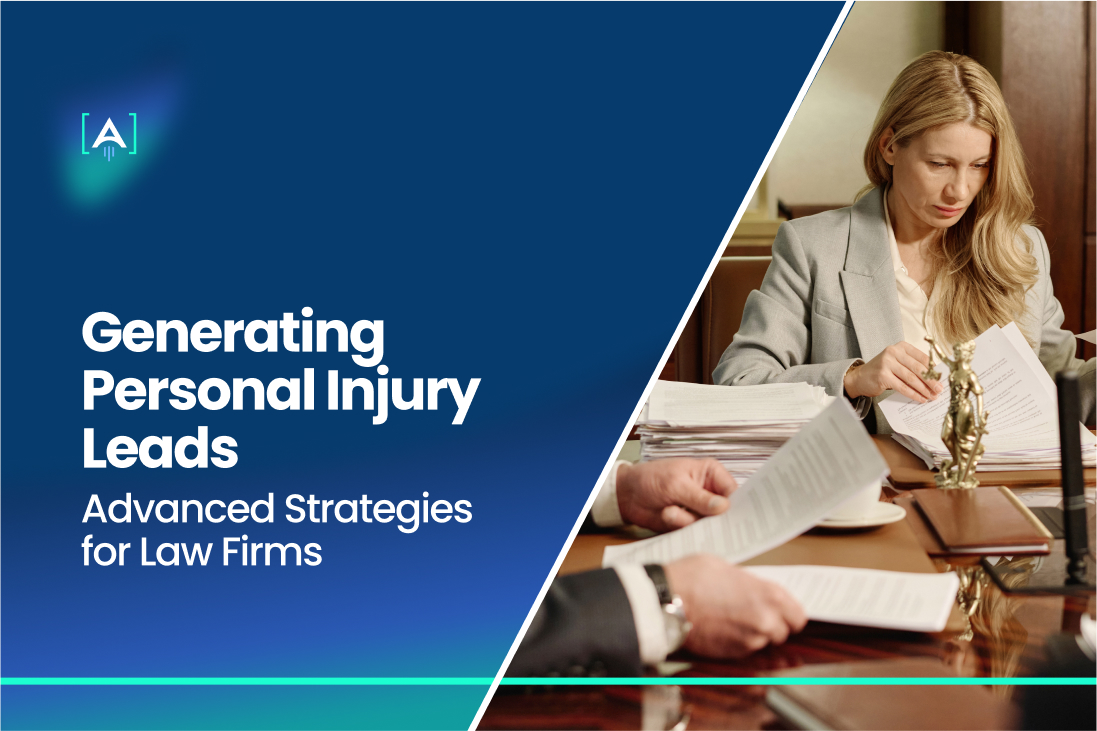Is generating leads for your personal injury law firm challenging? It’s an everyday struggle in the legal industry.
Personal injury lead generation is about building trust and providing solutions. With an effective legal marketing strategy, you can stand out from the crowd.
In this blog, we’ll introduce proven personal injury lead generation tactics.
The Importance of Personal Injury Lead Generation

By proactively identifying and engaging with individuals who have expressed interest or need legal assistance due to personal injuries, law firms can establish meaningful connections and nurture relationships that may lead to long-term client partnerships.
- Expansion of Client Base: Personal injury leads open doors to new markets, allowing law firms to broaden their reach and establish a stronger presence in the legal landscape. By actively seeking out potential clients who require legal assistance for personal injuries, firms can expand their client base and diversify their portfolio.
- Maximized Revenue Opportunities: Personal injury leads also provide law firms with many revenue-generating opportunities. By tapping into a steady stream of potential legal clients actively seeking legal representation for their personal injury cases, firms can capitalize on these opportunities to increase their revenue and grow their business.
- Establishment of Meaningful Connections: Law firms can initiate meaningful connections and nurture relationships with potential clients. These connections can lay the foundation for long-term client partnerships built on trust, reliability, and exceptional legal representation.
What is a Lead for a Personal Injury Law Firm?
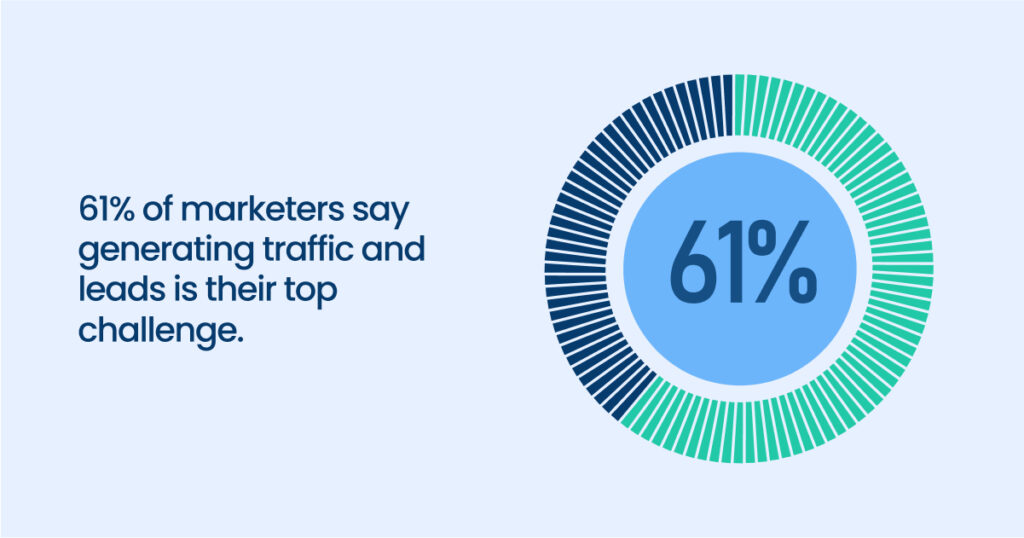
(source)
A lead for an injury law firm is someone who seeks legal assistance.
Individuals who contact a law firm seeking assistance for their injury-related case become legal leads.
These personal injury leads are potential clients seeking legal guidance and representation for personal injury matters.
For example, let’s say Tom is injured in a workplace accident and wants to explore his legal options.
He contacts a law firm specializing in personal injury cases and fills out a form detailing his accident. In this scenario, Tom becomes a legal lead for the law firm.
The law firm’s objective is to connect with legal leads like Tom, understand their situation thoroughly, and offer tailored legal services to help them pursue compensation and justice for their injuries.
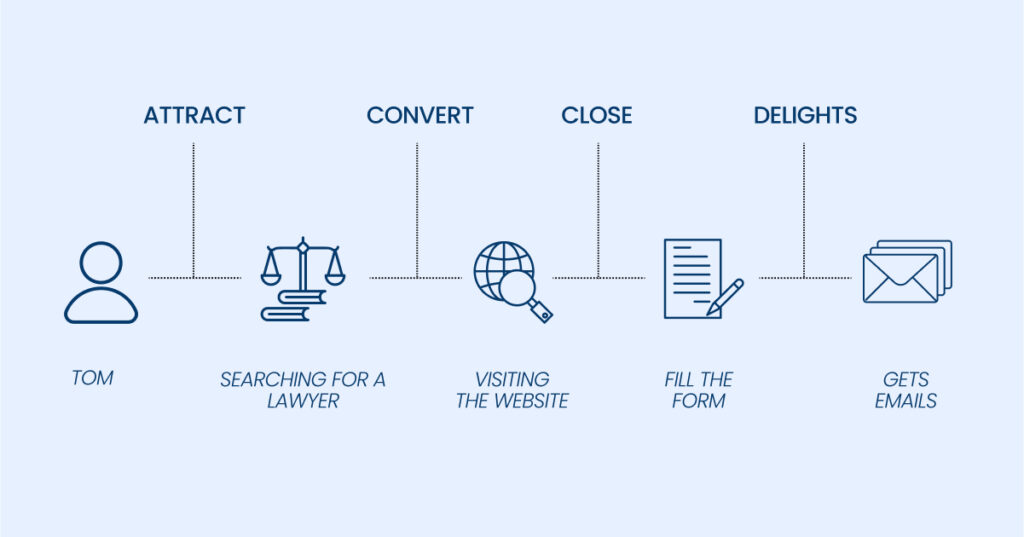
By effectively implementing lead generation strategies such as search engine optimization and content marketing, law firms can attract and convert legal leads into satisfied clients, thereby maximizing their online presence and revenue potential.
Types of Personal Injury Leads
There are different types of personal injury leads.
By recognizing the characteristics and intent of each lead type, you can better prioritize and nurture them for optimal results.
Warm Leads
These personal injury leads have shown a clear interest in pursuing legal action for their personal injury.
They may have contacted the firm directly or engaged with your content online.
Additionally, warm leads seeking legal assistance are further along in the decision-making process.
Cold Leads
Cold leads have shown initial interest in legal help but may not be actively engaged or ready to move forward.
They might have filled out a contact form or downloaded informational resources but have yet to act further.
Cold leads require more nurturing and persuasion to convert into active clients.
Referral Leads
Referral leads are recommended to the firm by previous clients, colleagues, or other professionals in the industry.
These personal injury leads often come with higher trust and credibility due to the recommendation from a trusted source.
Referral leads may already be familiar with the firm’s reputation and services.
Web Leads
Web leads are generated through online channels such as the firm’s website, social media platforms, or online advertisement.
These leads may have your law firm discovered through organic search results, paid advertisements, or social media posts.
Web leads vary in terms of their level of intent and engagement, requiring personalized follow-up and communication.
Qualified Leads
Qualified personal injury leads meet specific criteria the firm sets, indicating a higher likelihood of conversion.
These leads may have demonstrated attributes such as a certain level of damages, liability, or proximity to the firm’s location.
Qualified leads are prioritized for further engagement and follow-up to maximize conversion opportunities.
Personal Injury Lead Generation Strategies
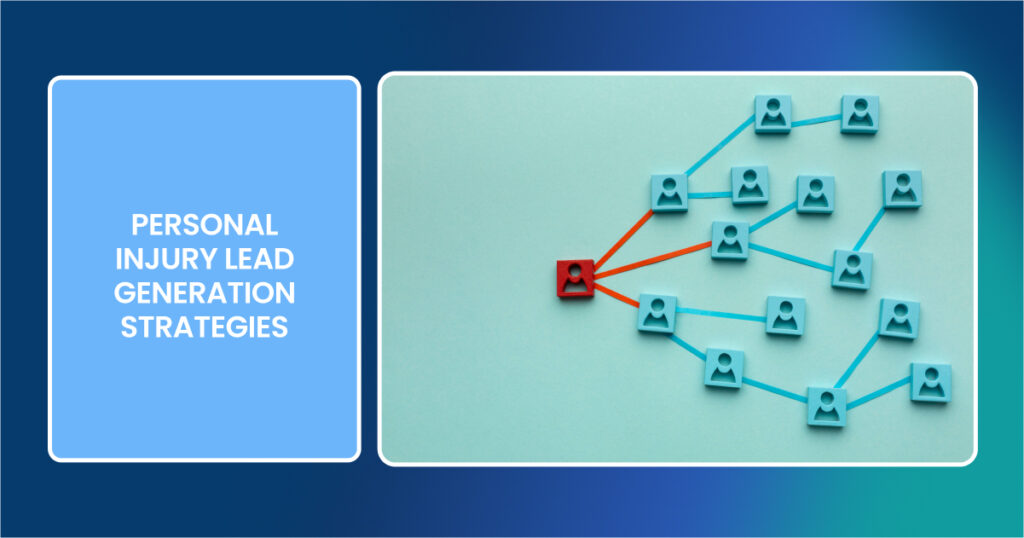
Let’s explore effective strategies to generate injury leads and convert them into clients.
Create Compelling Content
You can attract and nurture personal injury leads effectively by providing valuable resources and addressing the concerns of prospective clients.
Here are some strategies to leverage content to attract more injury leads:
Craft Educational Blog Posts
They offer a platform to provide insights, practical advice, and actionable tips to address the needs of potential clients while showcasing your firm’s expertise.
Car Accident FAQs:
- Craft blog posts that answer frequently asked questions about car accidents, such as “What Should I Do After a Car Accident?” or “How Long Do I Have to File a Car Accident Claim?”
- Provide step-by-step guidance, practical tips, and legal insights to help individuals navigate the aftermath of a car accident and understand their rights and options.
Slip and Fall Prevention Tips:
- Address common concerns and misconceptions surrounding slip and fall accidents by publishing blog posts on topics like “How to Prevent Slip and Fall Accidents at Home” or “Who Is Liable for Slip and Fall Injuries?”
- Offer practical advice, safety tips, and information on premises liability laws to educate individuals.
Understanding Workers’ Compensation:
- Write informative blog posts demystifying the workers’ compensation process, such as “What You Need to Know About Filing a Workers’ Compensation Claim” or “Common Myths About Workers’ Compensation.”
- Clarify eligibility requirements, outline the steps in filing a claim, and provide insights into the benefits available to injured workers.
Medical Malpractice Explained:
- Educate readers about medical malpractice laws and their rights as patients through blog posts like “Signs of Medical Malpractice to Watch Out For” or “How to Pursue Compensation for Medical Errors.”
- Offer guidance on identifying instances of medical negligence, seeking expert opinions, and navigating the complex legal landscape of medical malpractice claims.
Product Liability Risks:
- Inform consumers about product liability laws and their recourse in the event of defective products by publishing blog posts on topics such as “What to Do If You’re Injured by a Defective Product” or “Understanding Your Rights as a Consumer.”
- Provide insights into liability theories, recall procedures, and the role of manufacturers, distributors, and retailers in product liability cases.
Share Case Studies and Success Stories
Showcase how your personal injury lawyers and attorneys handle different personal injury cases.
Let’s say you must share the success story of a workers’ compensation case.
Present a compelling success story of a worker who obtained workers’ compensation benefits with your firm’s assistance, demonstrating your firm’s commitment to protecting the rights of injured workers.
Emphasize the favorable outcome achieved, such as securing compensation for lost wages, disability benefits, vocational rehabilitation, and medical expenses, showcasing your firm’s expertise in navigating the complexities of workers’ compensation claims.
Leverage Informative Videos
Creating video content is another effective personal injury lead-generation tactic. Videos can educate personal injury clients, humanize your firm, and establish credibility in the legal field.
Explaining Legal Concepts:
- Create videos that break down complex legal concepts related to personal injury into easy-to-understand explanations.
- For example, you could produce a video that explains the elements of negligence in a personal injury case or outline the statute of limitations for filing a claim.
Discussing Recent Court Rulings:
- Produce videos that analyze and discuss recent court rulings or legal developments. This could include Supreme Court decisions, appellate court rulings, or legislation changes impacting personal injury claims.
- Offer insights into the implications of these rulings for legal leads and guide how they may affect their legal rights and options.
Providing Insights into the Claims Process:
- Create videos that guide clients through the entire personal injury claims process, offering a step-by-step overview from beginning to end.
- Offer practical tips, best practices, and pitfalls to avoid to help potential clients navigate the claims process with confidence.
Sharing Client Testimonials and Success Stories:
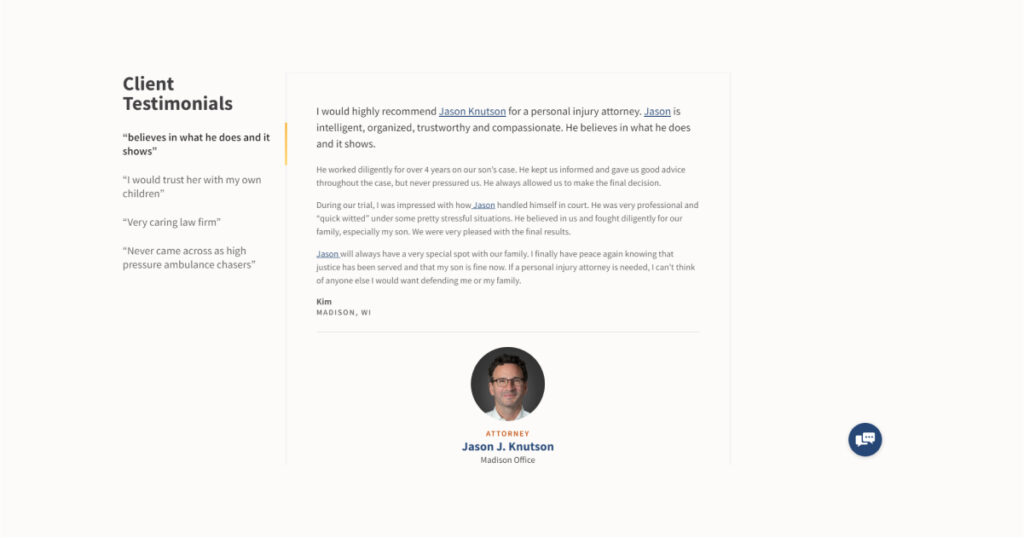
- Feature videos that showcase client testimonials and success stories, allowing satisfied clients to share their experiences working with your firm. Hearing from past clients can humanize your firm and build trust with potential clients.
- Highlight the positive outcomes achieved for clients, including financial compensation, justice served, and the impact of your firm’s representation on their lives.
Optimize Your Website
Your website is a powerful tool for your injury law firm.
Website optimization is crucial for maximizing online visibility, engaging visitors, and ultimately driving lead generation.
Importance of Website Optimization
- Improved Visibility: A well-optimized website ranks higher, making it easier for people searching for personal injury legal services online to find your website. Improved visibility increases your chances of attracting relevant traffic to your site.
- Improved User Experience: An optimized website provides visitors with a seamless and user-friendly experience, reducing bounce rates and encouraging prolonged engagement. A positive user experience enhances the likelihood of visitors exploring your services and converting them into quality legal leads.
- Increased Conversion Rates: By strategically optimizing your website’s layout, content, and functionality, you can more effectively guide visitors through the conversion funnel. Clear calls to action, streamlined navigation, and compelling content all contribute to higher conversion rates.
- Credibility and Trust: A visually appealing and informative website reflects positively on your firm’s reputation and credibility, making visitors more inclined to engage with your services.
- Data-Driven Insights: Website optimization allows you to gather visitors’ data and insights to make informed decisions to further refine and improve your personal injury lead generation strategies.
Strategies for Website Optimization
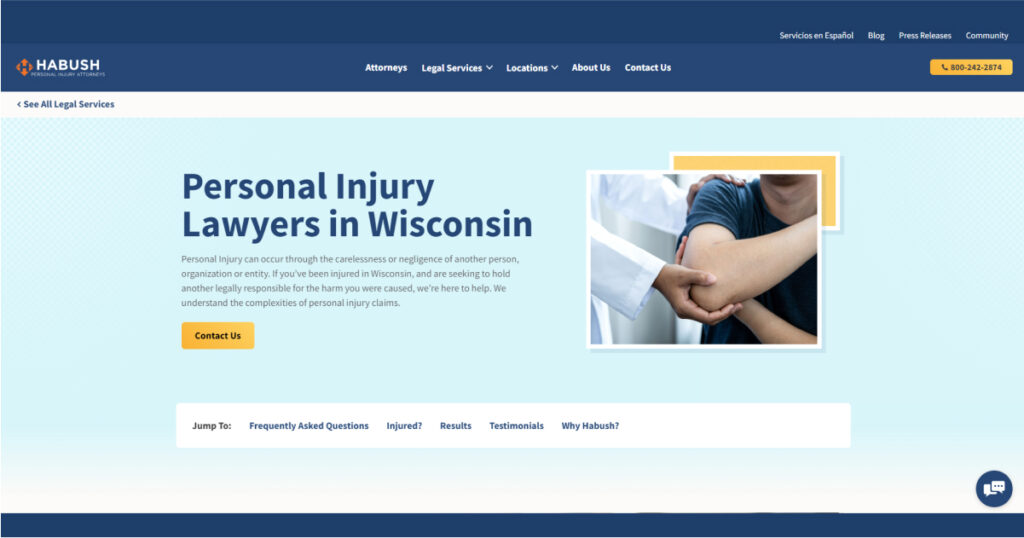
Let’s explore specific strategies to optimize your website effectively:
Insert Clear Calls-to-Action (CTAs):
- Ensure that your website includes visible and persuasive prompts, encouraging visitors to perform specific actions like contacting your firm or downloading a free guide.
- For example, you can strategically place prominent buttons or banners with phrases like “Contact Us Now” or “Schedule Free Case Evaluation” throughout your website. These CTAs should stand out visually and convey a sense of urgency to encourage immediate action from potential personal injury clients.
Place Contact Forms Strategically:
- Incorporate strategically placed contact forms on key pages of your website, such as the homepage, practice area pages, and blog posts. These contact forms should be easy to find and use, allowing visitors to submit their inquiries or requests for consultations quickly and conveniently. Consider using eye-catching designs and compelling copy to encourage engagement.
- For instance, you can offer a free case evaluation or consultation in exchange for visitors filling out the contact form, providing added value and an incentive for them to contact your firm.
Create Tailored Landing Pages:
- These landing pages should contain targeted content, relevant keywords, and persuasive messaging to attract potential clients. By tailoring your landing pages to specific search queries and user intent, you can increase the likelihood of personal injury lead generation.
- For example, if your firm specializes in car accident cases, you can create a landing page that highlights your expertise in this area, provides information about common types of car accidents, and offers guidance on what to do after an accident.
Optimize for Mobile:
Use responsive design principles so that your website looks and operates well in all screen sizes and resolutions.
Additionally, prioritize fast loading times, intuitive navigation, and mobile-friendly features such as click-to-call buttons and easy-to-fill contact forms.
With more and more users accessing the internet from mobile devices, mobile optimization is essential for personal injury lead generation.
Incorporate Social Proof and Trust Signals:
- Social proof includes elements such as client testimonials, reviews, ratings, awards, certifications, and affiliations with professional organizations. Display these social proof elements prominently on your website’s homepage, landing pages, and contact page to reassure potential clients of your firm’s expertise and reputation.
- For example, you can showcase testimonials from satisfied clients who have successfully received compensation for their personal injury claims or highlight any awards or accolades your firm has received for its outstanding legal services.
Social Media Marketing: Engaging with Potential Clients
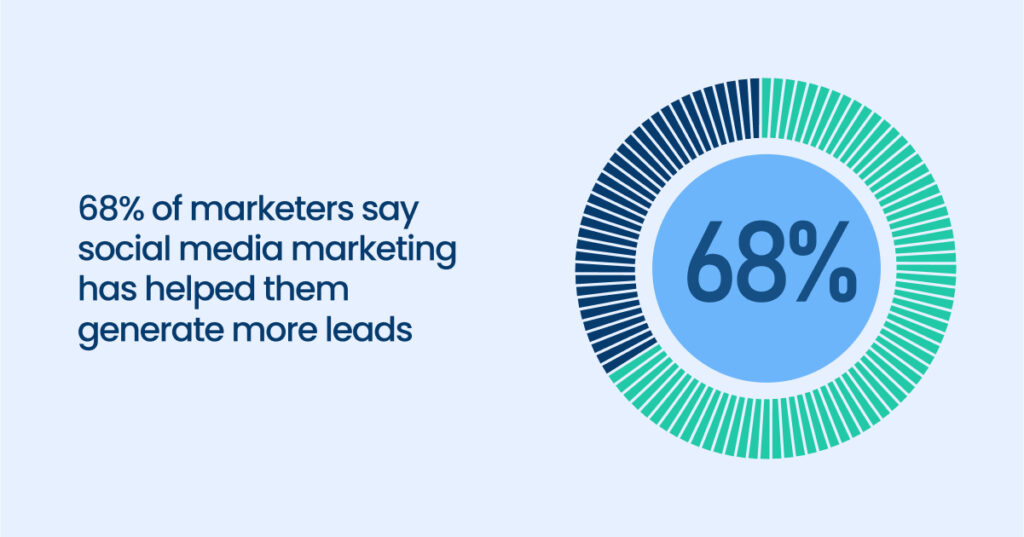
(source)
Social media marketing allows personal injury law firms to reach and engage with potential clients on platforms like Facebook, Twitter, LinkedIn, and Instagram.
You can foster meaningful interactions, demonstrate your firm’s commitment to helping others, and ultimately attract quality personal injury leads.
Content Sharing and Promotion:
- Share informative and relevant content on your social media channels, including blog posts, articles, case studies, videos, and infographics.
Engagement and Interaction:
- Initiate conversations, ask questions, and encourage feedback to foster meaningful interactions and build relationships with potential clients.
Community Building:
- Share valuable resources, participate in relevant discussions, and provide support and guidance to community members.
Educational Content and Tips:
- Provide educational content and practical tips on personal injury-related topics to empower and inform your audience.
- Offer insights into common legal issues, rights and responsibilities, and steps to take in the event of a personal injury to position your firm as a valuable resource for potential clients.
Promotions and Contests:
- Run promotions, giveaways, or contests on social media to attract new followers and legal leads.
- Offer prizes or discounts for participating in contests, sharing content, or referring others to your firm, encouraging audience participation and virality.
Networking and Collaboration:
- Network with other legal professionals, industry influencers, and complementary businesses on social media to expand your reach and visibility.
- Collaborate on joint projects, share content, and exchange referrals to leverage each other’s networks and improve personal injury lead generation efforts.
Email Marketing
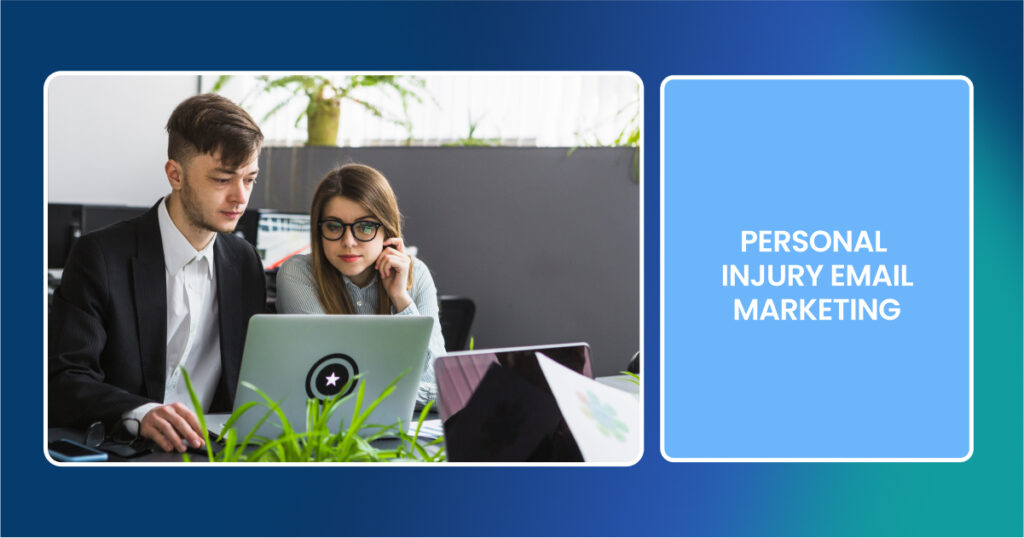
Imagine having a direct line of communication with potential clients, where you can deliver tailored messages, valuable insights, and exclusive offers to their inboxes.
That’s the power of email marketing for personal injury law firms.
It is one of the best legal marketing strategies for nurturing relationships and driving meaningful engagement.
Let’s outline a specific email marketing campaign to attract personal injury leads.
Campaign Objective:
The goal of this email marketing campaign is to attract personal injury leads by providing valuable information, showcasing expertise, and fostering trust.
Email Sequence for Personal Injury Law Firms

(source)
Introduction email
- Begin your email marketing campaign with a compelling introduction email that sets the stage for future communication. Introduce your personal injury attorneys and lawyers, including a brief overview of your firm’s history and mission, and invite recipients to learn more about your firm.
Educational Content Series:
- Develop a series of educational emails that provide valuable insights into various aspects of personal injury, such as common types of accidents, legal rights and responsibilities, and steps to take after an injury.
- Each email should focus on a specific topic and provide actionable advice, practical tips, and resources to help recipients understand their legal options and make informed decisions.
Case Study Highlights:
- Highlight compelling case studies and success stories that illustrate the positive outcomes your firm has achieved for past clients.
- Mention key details of each case, including the nature of the injury, challenges faced, legal strategies employed, and the final resolution.
- Emphasize the impact of your firm’s representation on clients’ lives, such as financial compensation received, justice served, and the restoration of peace of mind.
Interactive Webinar or Q&A Session:
- Invite recipients to an interactive webinar or Q&A session to engage directly with each personal injury attorney, ask questions, and get personalized advice.
- Choose a relevant topic that addresses common concerns or interests among your target audience, such as understanding the claims process or determining liability in personal injury cases.
Follow-Up and Engagement Emails:
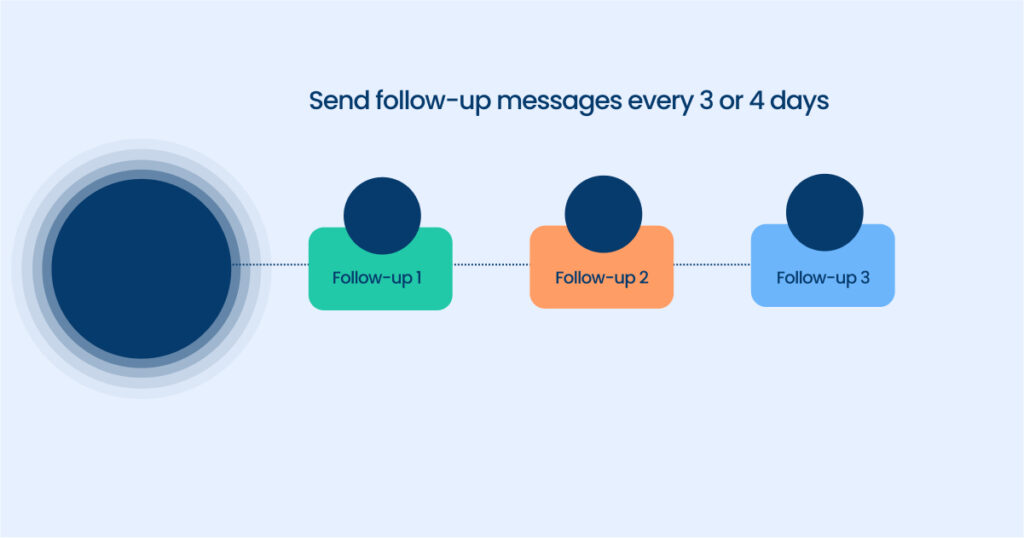
- Follow up with recipients who have engaged with previous emails or attended your webinar to nurture relationships and move them closer to conversion.
- Send personalized follow-up emails that address any questions or concerns raised during the webinar, provide additional resources or information, and encourage further communication.
- Stay engaged with recipients through regular email communication, sharing relevant updates, insights, and offers to keep your firm top-of-mind as they consider their legal options.
Let Azarian Growth Agency Generate Leads for Your Law Firm
So, these were the marketing strategies to generate personal injury leads every personal injury lawyer must know.
If your law firm seeks to maximize its online presence and attract legal leads, consider partnering with a personal injury lead generation company or agency like [A] Growth Agency.
With a deep understanding of the legal marketing landscape, we employ a mix of search engine marketing, optimization, content marketing, and other effective strategies to generate personal injury leads and convert them into clients.
We’re dedicated to helping your law firm thrive.
